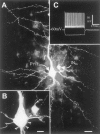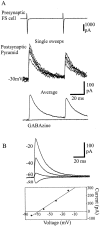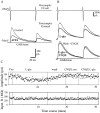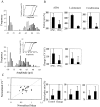Kainate receptors regulate unitary IPSCs elicited in pyramidal cells by fast-spiking interneurons in the neocortex
- PMID: 11312283
- PMCID: PMC6762560
- DOI: 10.1523/JNEUROSCI.21-09-02992.2001
Kainate receptors regulate unitary IPSCs elicited in pyramidal cells by fast-spiking interneurons in the neocortex
Abstract
Unitary IPSCs elicited by fast-spiking (FS) interneurons in layer V pyramidal cells of the neocortex were studied by means of dual whole-cell recordings in acute slices. FS to pyramidal cell unitary IPSCs were depressed by (RS)-S-amino-3-(3-hydroxy-5-tert-butylisoxazol-4-yl) (ATPA), a kainate (KA) receptor agonist, and by the endogenous agonist l-glutamate in the presence of AMPA, NMDA, mGluR, and GABA(B) receptor antagonists. This effect was accompanied by an increase in failure rate of synaptic transmission, in the coefficient of variation, and in the paired pulse ratio, indicating a presynaptic origin of the IPSC depression. Pairing the activation of the presynaptic neuron with a depolarization of the postsynaptic cell mimicked the decrease of unitary IPSCs, and this effect persisted when postsynaptic sodium action potentials were blocked with the local anesthetic QX314. The effects of ATPA, glutamate, and of the pairing protocol were almost totally blocked by CNQX. These data suggest that KA receptors located on presynaptic FS cell terminals decrease the release of GABA and can be activated by glutamate released from the somatodendritic compartment of the postsynaptic pyramidal cells.
Figures





References
-
- Alger BE, Pitler TA. Retrograde signalling at GABAA-receptor synapses in the mammalian CNS. Trends Neurosci. 1995;18:333–340. - PubMed
-
- Angulo MC, Rossier J, Audinat E. Postsynaptic glutamate receptors and integrative properties of fast-spiking interneurons in the rat neocortex. J Neurophysiol. 1999a;82:1295–1302. - PubMed
Publication types
MeSH terms
Substances
Grants and funding
LinkOut - more resources
Full Text Sources
